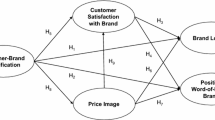Abstract
We investigated how brand attributes, familiarity and consideration, and residuals of prior marketing mix exposures on individuals influence the intention to purchase. We employed a Bayesian view point to make probability statements about the parameters and express uncertainty in a probability or distribution statement. We used a behavioral data set of US auto industry. Nine thousand six hundred seventy-five observations were used in the analysis. Prior literature neglected to take into account the customer-brand relationship variables which may explain unobserved customer heterogeneity. Our brand choice model builds on a set of behavioral variables and focuses on the brand dimensions. Within a Bayesian framework, we proposed a new brand choice model which accounts for the customer-brand relationship. Our mixed model showed familiarity and brand loyalty vary by segment; brand loyalty is the most important predictor of purchase intention for each segment. Besides, our mixed model indicated fixed effect of the interaction between familiarity and attachment to be a significant predictor of purchase intention. We showed that consideration positively and brand attachment negatively are associated with purchase intention. Our results regarding negative effect of brand attachment on purchase intention suggest further investigation of possible moderating factors of the relationship between brand attachment and purchase intention.
Access this chapter
Tax calculation will be finalised at checkout
Purchases are for personal use only
Similar content being viewed by others
References
Aaker, D. A. (1991). Managing brand equity: Capitalizing on the value of a brand name. New York: The Free Press.
Aaker, J. (1997). Dimensions of brand personality. Journal of Marketing Research, 34, 347–357.
Dwayne Ball, A., & Tasaki, L. H. (1992). The role and measurement of attachment in consumer behavior. Journal of Consumer Psychology, 1(2), 155–172.
Elrod, T., & Winer, R. S. (1982). An empirical evaluation of aggregation approaches for developing market segments. Journal of Marketing, 46, 65–74.
Fournier, S. (1998). Customers and their brands: Developing relationship theory in consumer research. Journal of Consumer Research, 24, 343–353.
Guadagni, P. M., & Little, J. D. C. (1983). A logit model of brand choice calibrated on scanner data. Marketing Science, 2, 203–238.
Howard, J. A., & Sheth, J. N. (1969). The theory of buyer behavior (Vol. 14). New York: Wiley.
Jacoby, J., & Chestnut, R. (1978). Brand loyalty measurement and management. New York: Wiley.
Keller, K. L. (2003). Strategic brand management. New York: Prentice Hall.
Kleine, S. S., & Baker, S. M. (2004, January). An integrative review of material possession attachment. Academy of Marketing Science Review. Retrieved June 15, 2010, from http://www.amsreview.org/articles/kleine01-2004.pdf.
Levy, S. J. (1985). Dreams, fairy tales, animals, and cars. Psychology and Marketing, 2, 67–81.
Mikulincer, M., & Shaver, P. R. (2007). Boosting attachment security to promote mental health, prosocial values, and inter-group tolerance. Psychological Inquiry, 18(3), 139–156.
Oliver, R. L. (1999). Whence consumer loyalty? Journal of Marketing, 63, 33–44.
Plummer, J. (1985). How personality makes a difference. Journal of Advertising Research, 24, 27–31.
Reichheld, F. F. (1996). The loyalty effect: The hidden force behind growth, profits and lasting value. Boston: Harvard Business School Press.
Schouten, J. W., & McAlexander, J. H. (1995). Subcultures of consumption: An ethnography of the new bikers. Journal of Consumer Research, 22, 43–61.
Thomson, M. (2006). Human brands: Investigating antecedents to customers’ strong attachments to celebrities. Journal of Marketing, 70, 104–119.
Whan Park, C., MacInnis, D. J., Priester, J., Eisingerich, A. B., & Iacobucci, D. (2010). Brand attachment and brand attitude strength: Conceptual and empirical differentiation of two critical brand equity drivers. Journal of Marketing, 74, 1–17.
Author information
Authors and Affiliations
Corresponding author
Editor information
Editors and Affiliations
Rights and permissions
Copyright information
© 2017 Academy of Marketing Science
About this paper
Cite this paper
Sardashti, H., Calantone, R. (2017). A Brand Loyalty and Attachment-Based Bayesian Brand Choice Model. In: Stieler, M. (eds) Creating Marketing Magic and Innovative Future Marketing Trends. Developments in Marketing Science: Proceedings of the Academy of Marketing Science. Springer, Cham. https://doi.org/10.1007/978-3-319-45596-9_117
Download citation
DOI: https://doi.org/10.1007/978-3-319-45596-9_117
Published:
Publisher Name: Springer, Cham
Print ISBN: 978-3-319-45595-2
Online ISBN: 978-3-319-45596-9
eBook Packages: Business and ManagementBusiness and Management (R0)




